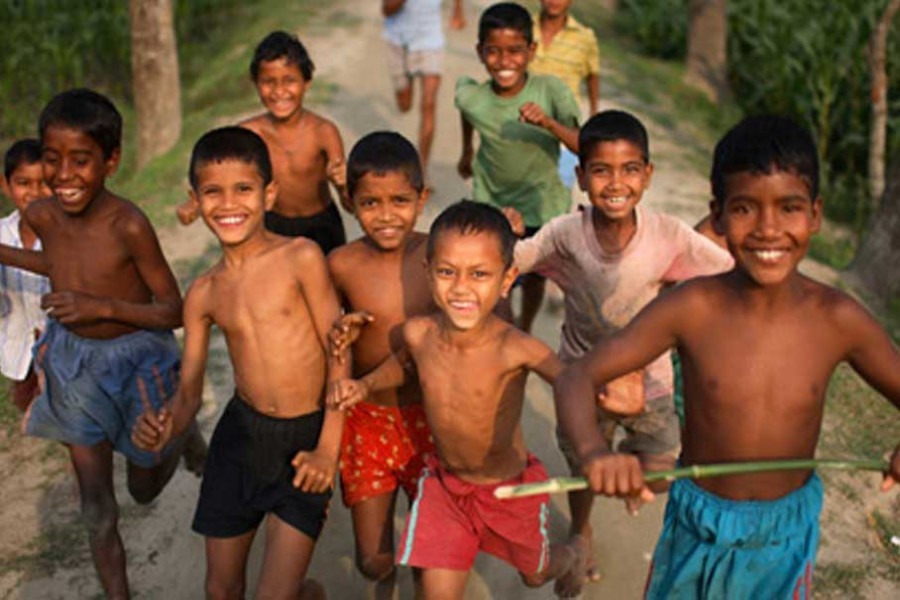
Published :
Updated :

The higher dropout rate of primary school girls had for decades been the common scenario in Bangladesh. Thanks to scores of socio-economic factors, girls forced to not attend school had been the common reality. Thus the girls in general could hardly go beyond class three or class four. Many of them would be made to engage in household work, or married off prematurely without their understanding anything. This was once the common primary education scenario in Bangladesh. It eventually led to a dropout rate much higher than that among the male students.
Over the last few years, vast areas of the country have been witnessing an extraordinary spectacle: fast decline in the dropout rate among primary school girl students. These were among the recent findings of the Directorate of Primary Education and Bangladesh Bureau of Educational Information. On the back of the country's impressive performance in achieving the target of Millennium Development Goals (MDGs) in the sector of universal primary education, the government's emphatic focus on primary-stage girls worked the magic. It came in the form of government stipends for female students at primary schools. In fact, no stimulus can be compared even distantly to those involving money. Against the backdrop of the long marginalised and adversely treated girl students, the monthly stipends served as a great fillip to the primary-stage female learners. Proving the initiative a pragmatic and child education-friendly one launched by the policymakers, it made a positive impact on the female students and their parents. Like never in the past, parents were found showing interest in enrolling their daughters on primary schools.
But the system of providing stipends to only the girls at government primary schools made way for repulsion for school among the male students. Primary education experts also smelt the creeping of an unwittingly adopted discriminatory policy against boys. The girls-only stipends led to disillusionment and depression among the male students and their parents. In fact, this development was unwarranted. According to a freshly conducted survey of the Directorate of Primary Education, and quoted by a news agency, 17.9 per cent of primary students dropped out in 2019. The dropout rate for boys was 3.5 percentage points higher than that for girls, the directorate added. To many experts, the survey reflected a completely reverse trend in the dropout malady. The trend presumably had its roots in the non-inclusion of the male primary students in the stipend facility. It's worth mentioning that there were a total of more than 20 million students at government-run and private primary schools in 2019. Of them girls accounted for 51.08 per cent of the total number of students.
The male primary students were, however, made eligible for the stipend in 2015. Around 14 million primary students are receiving the government stipend at the moment. Pre-primary students are also included in the network. These kids now receive Tk 75 a month. Students in classes I-V get a stipend amount of Tk 150. Learners studying in Class VI-Class VIII are awarded a monthly stipend of Tk 200.
The crux of the matter is the dropout rate among the male primary students is still higher than that of girls. As has been observed by some educationists, it might take some time for the boys to get used to the stipend culture and benefit from it. It's because they are unaccustomed to the monetary incentive provided by school. They have never received any monthly monetary incentive from the authorities earlier, except the sum given in the form of primary scholarship to meritorious students. As the situation has unfolded lately, most of the parents willing to enrol their boys on school are not aware of the stipends. Like they have done to female students, the stipend benefits have started playing a positive role in bringing boys back to school like seen before, say a number of experts.
A large section of academics propound the idea of extending the stipend facility to the disadvantaged child students at non-formal schools as well. They are already deprived of a number of basic infrastructural facilities. Dropout rates at these schools also keep rising. Introduction of stipends is expected to reduce the trend of discontinuing their studies at these schools. In the context of the government's avowed goal of completely freeing the country of the curse of illiteracy, it should continue to expand the sphere of schools with stipend facility. Even the adult education centres ought not to be excluded.
According to high officials overseeing the primary curricular activities, the countrywide dropout rate has declined remarkably. What impedes the way of arriving at a foolproof conclusion on dropouts is proper and scientific calculation. But there are clear signs that dropout rates have declined significantly in both rural and urban areas. It has been endorsed by the country's development partners. Against this backdrop, making the male primary students eligible for stipends has significantly helped cut down the dropout rate.
That keeping stipends limited to only the girls -- in view of their many disadvantages, and leaving out the boys, could be interpreted as discrimination of sorts. It had apparently lost on the policymakers. The equitable distribution of the incentive would not have seen the primary school boys dropping out in large numbers. It's true, female child learners deserve to be in focus of the networks of all government benefits. But providing financial incentives to them should not be implemented by undermining boys. The policy has no scope for being lopsided.


 For all latest news, follow The Financial Express Google News channel.
For all latest news, follow The Financial Express Google News channel.